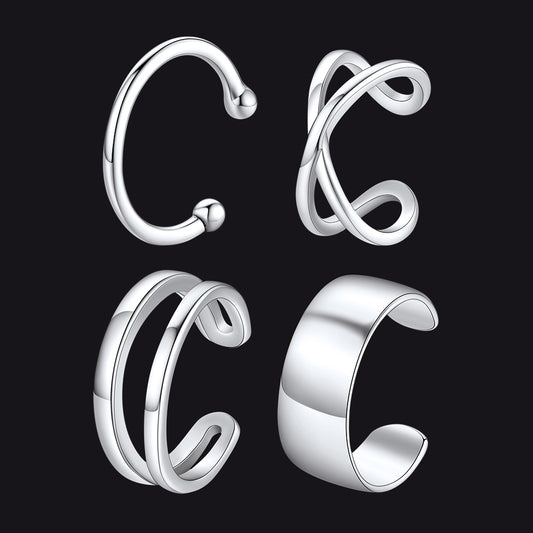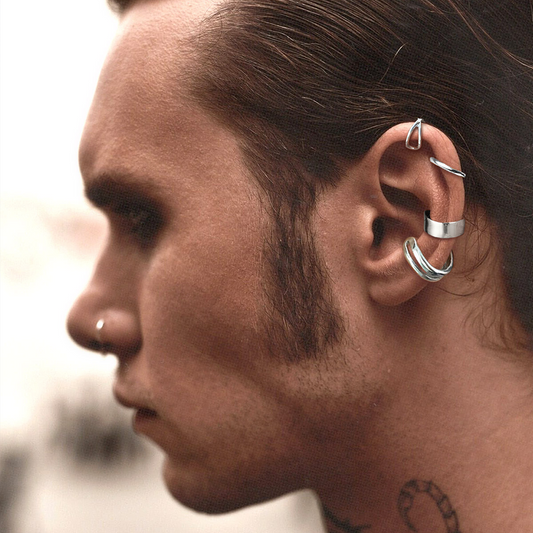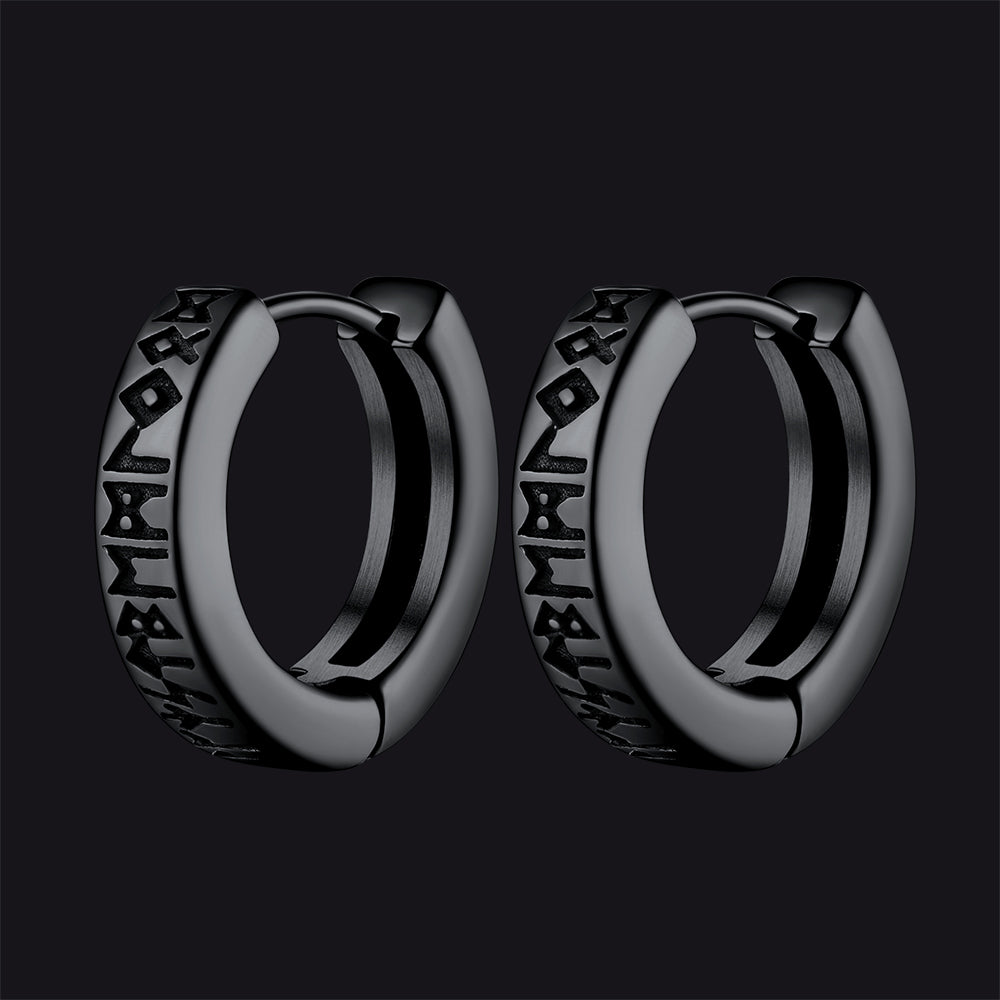How Do Men Achieve All-Day Comfort with Their Earrings?
Wearing uncomfortable earrings is like wearing shoes that are a size too small. They might look good, but they're miserable to live with. Many guys think this is just the price of wearing jewelry, but it doesn't have to be. The secret to comfortable men's earrings isn't a high pain tolerance. It's about making smart choices on material, weight, and fit . Here's what you need to know to wear your style without the soreness.
Earlobe Anatomy: Why Your Ears Get Sore and Itchy
Your earlobe is a soft, fleshy area filled with nerve endings and tiny blood vessels. This composition makes it uniquely sensitive to pressure and foreign materials. A piercing creates a permanent tunnel through this sensitive spot, which is why it can get irritated so easily. When your ear starts to itch, swell, or turn red, it's usually not a random event. It's often an allergic reaction to the metal touching your skin.
The main culprit is nickel. It's a cheap metal frequently mixed into jewelry to add strength and shine, but a huge number of people are allergic to it. If you get that tell-tale itchy, red rash after putting in an earring, nickel is the likely cause .
While nickel gets the most blame, other metals can cause trouble. Copper and brass, common in plated jewelry, can also lead to irritation. They're the reason you sometimes get a green or black stain on your skin . Figuring out that your body is reacting to a specific metal is the first real step toward finding comfortable men's earrings .
Pillar 1: Choose the Right Earring Materials for All-Day Wear

The number one reason for earring discomfort is the material itself. Choosing a metal that is safe for the body and doesn't cause allergies will eliminate most itching problems from the start. For long-lasting ease, here is a list of the best materials.
- Titanium (Implant-Grade): This is the safest choice, period. It's the same material used for medical implants, so it's designed not to react with your body. It's 100% nickel-free and super lightweight. If you have very sensitive skin or just want a guarantee of zero irritation, choose titanium .
- Surgical Steel (316L): A durable and affordable body-safe option, and it's what most professional piercers use for new piercings. It's a solid, reliable choice for daily comfort. This material is often suggested for men's first earrings due to its favorable properties. While it can contain a tiny amount of nickel, the metal is bonded in a way that it doesn't bother the vast majority of people.
- Niobium: Another top-tier hypoallergenic metal, similar to titanium. It's completely nickel-free and won't tarnish. A cool bonus is that niobium can be treated to come in a variety of bright colors, giving you more style options without sacrificing comfort.
- Platinum: This is the premium, top-shelf option. Platinum is extremely tough, won't tarnish, and is naturally hypoallergenic because of its purity. It costs more, but it's a true "wear-it-and-forget-it" metal that will last forever.
- Gold (14k or Higher): With gold, the karat number is key. Pure 24k gold is too soft for jewelry, so it's mixed with other metals. Stick to 14k or 18k gold—these have less nickel and other cheap alloys, making them safe for most people. Avoid gold-plated jewelry. The thin gold coating wears off quickly, exposing your skin to the irritating metal underneath.
- Sterling Silver (.925): Made of 92.5% pure silver (the rest is usually copper), sterling silver is generally a safe and nickel-free choice. Its main drawback is that it tarnishes easily and needs regular polishing. For a very small number of people, the copper can be an irritant .
Pillar 2: Consider the Impact of Earring Weight, Size, and Style

After picking a safe metal, the physical design is your next step. A heavy or clunky earring can cause a dull ache, even if it's made of pure platinum. For true all-day comfort, the weight, size, and style of your earring are just as important as the material.
Earring Weight
The constant pull from a heavy earring gets uncomfortable fast and can even stretch your piercing over time. Here's a simple breakdown of what different weights feel like.
| Weight Range | Feels Like | Best For |
|---|---|---|
| Under 1 gram | A paperclip | "Wear-it-and-forget-it" comfort |
| 1 – 3 grams | A U.S. dime | The sweet spot for daily wear |
| 4 – 7 grams | A U.S. quarter | A few hours; a night out |
| 8+ grams | Multiple quarters | Special occasions, very short term |
All day long, the constant pull of a heavy earring can cause a dull, aching pain. Eventually, if you're not careful, it can even stretch the piercing hole permanently. For everyday wear, you should barely notice that your earrings are there. Look for hollow, thin, or small designs. When shopping online, look for the weight in the product description. For all-day comfort, aim for that 3-gram-or-less sweet spot.
Earring Style
Different styles offer different levels of comfort and practicality.
- Men's Stud Earrings: These are the clear winners for everyday comfort. Their small design sits flush against the earlobe, so they won't snag on clothes, headphones, or pillows. A simple, lightweight stud is a perfect 24/7 option.
- Men's Hoop Earrings (Huggies): If you like hoops, choose a “huggie” style. These are small men's hoop earrings that sit close to your ear. Their low profile makes them comfortable and much less likely to get caught on things. Larger, heavier hoops can create a pendulum effect, placing more strain on the piercing.
- Dangle/Drop Earrings: These make a great statement but are less suited for constant wear. Their movement and weight can pull on your piercing, so it's best to save dangle earrings for shorter events.
Pillar 3: Don't Overlook the Earring Backing
The small piece that holds your earring in place is more important than you might think . A bad backing can poke you, pinch your skin, and trap gunk, ruining an otherwise perfect earring. The common butterfly back is what most people are used to, but there are far more comfortable and secure options available, especially for men's earrings worn daily. -
| Backing Type | Best For | Pros | Cons |
|---|---|---|---|
| Flat Back (Labret) | Sleeping, headphones, 24/7 comfort | - Completely flat against the skin- No poking at all- Very secure | - Can be tricky to put on by yourself |
| Screw Back | Security, valuable studs, sleeping | - Won't fall off- Smooth, rounded back doesn't poke- Secure fit | - Tiny threads can be hard to handle |
| Silicone/Rubber Push Back | A quick comfort upgrade, sensitive skin | - Soft and flexible- Hypoallergenic- Good grip on the post | - Can stretch out and become loose over time |
| Butterfly Back | Inexpensive earrings, short-term wear | - Very common- Easy to put on and take off | - The post pokes you when sleeping- Easily traps oil and dirt- Can feel loose |
Pillar 4: Practice Good Hygiene and Daily Care

Even the most expensive earrings can become uncomfortable if you don't keep your piercings clean. Skin oils, sweat, and bacteria can build up, leading to that funky "earring smell," irritation, or even an infection. A few simple habits will prevent these problems and keep your piercings feeling great.
- Clean Your Earrings Weekly. Take your jewelry out a few times a week and wash it with gentle, fragrance-free soap and warm water. Don't forget the backings. You can also wipe your earlobes with a sterile saline solution, which is great for soothing any minor sensitivity.
- Take Them Out at Night. Giving your ears a break while you sleep is a great habit. It relieves any constant pressure on the piercing hole and allows the skin to breathe. This simple step makes a huge difference in all-day comfort.
- Remove Them for Water and Workouts. Take your earrings out before you shower, swim, or hit the gym. Chlorine, salt water, and sweat are major irritants. It also prevents your earrings from getting residue from soap and shampoo, or snagging during physical activity.
Cuff Earrings Set in Silver
FAQs About Earrings' Comfort
Q: Can I sleep with my earrings in?
A: It's generally better not to , as it can cause irritation and pressure. If you do, choose small studs with flat backs or screw backs . These designs minimize the chance of the post poking you. Never sleep in new piercings until they are fully healed according to your piercer's instructions.
Q1: My healed piercing is suddenly sore. What should I do?
A: First, remove the earring causing the issue. Gently clean your earlobe with a sterile saline solution. The soreness could be from a slight irritation, an allergic reaction to a new earring, or trapped bacteria. Switch to a proven hypoallergenic earring, like one made of titanium, and see if the soreness goes away. If the pain, redness, or swelling gets worse, it's best to see a doctor.
Q2: How do I know if I have a nickel allergy?
A: The main signs are localized itching, redness, and a rash that develops on your earlobe within hours or a few days of wearing a piece of jewelry. Your skin might also become dry, swollen, or form tiny blisters. The best way to know for sure is to see a dermatologist, who can perform a simple patch test to confirm the allergy .
Q3: Are expensive earrings always more comfortable?
A: Not at all. Comfort is about the material and the design, not the price . A $20 pair of implant-grade titanium studs will be far more comfortable for someone with sensitive skin than a $200 pair of 10k gold earrings that have a higher nickel content. Focus on quality materials first.





